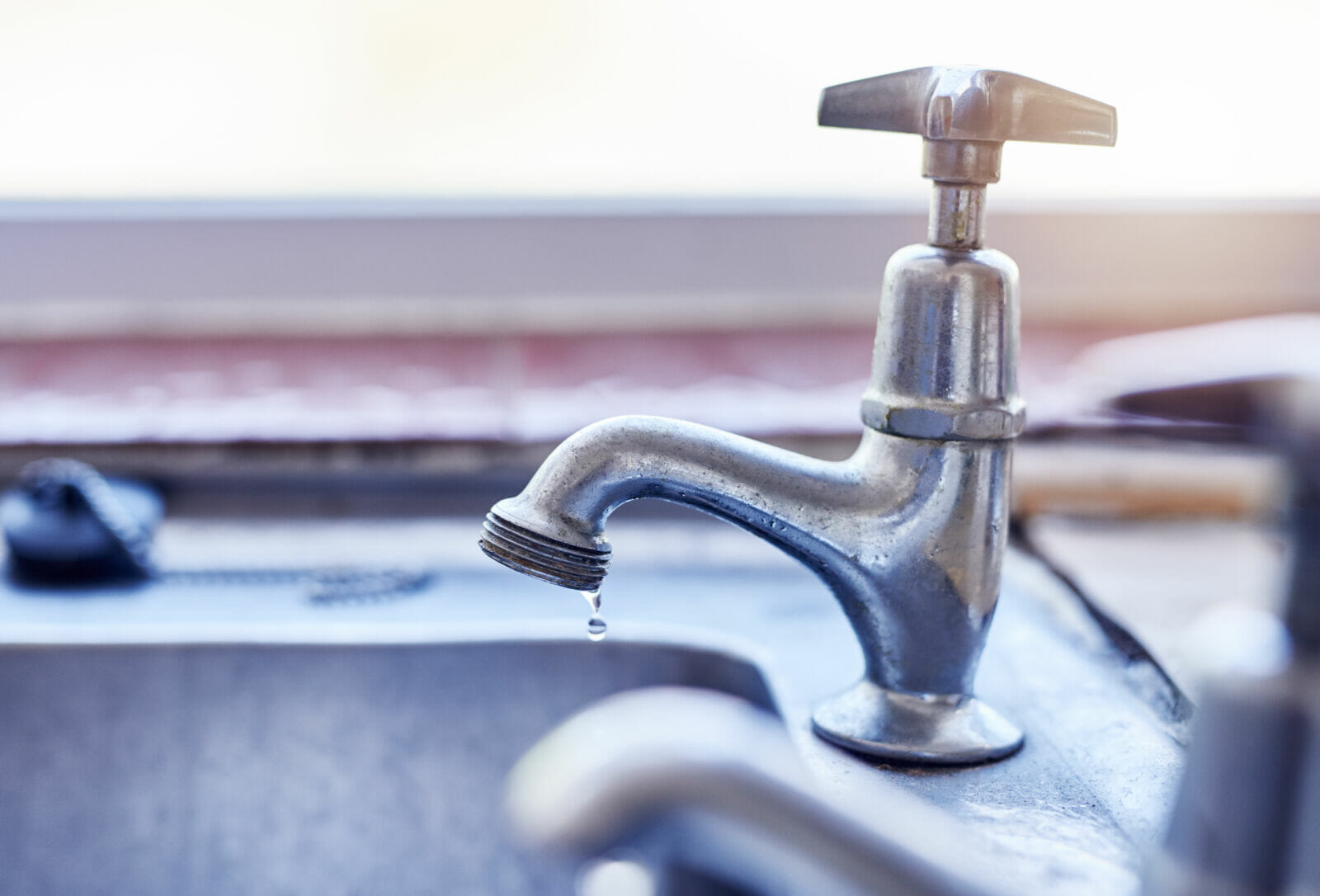With infrastructure that is aging and needs replacement, municipal water departments in the Colorado River basin are starting to invest in new systems that will help cities adapt to a future with a smaller water supply. But that means big spending, costs that will get passed along to the millions of people who use that water in sinks, showers and sprinklers.
“There’s literally nothing else you can have 1,000 gallons of delivered to your house at 2 in the morning for a few bucks,” said Mark Marlowe, water director in Castle Rock, Colorado.
LEARN MORE: Will water and capital concerns cool white-hot industrial market?
Marlowe and other water experts across the arid West agree, the amount you pay for tap water should probably go up, and likely will over the next few decades — in large part due to aging infrastructure.
“Our utilities are, at this point, middle-aged,” said Kathryn Sorensen, former director of the water department in Phoenix.
Major Western cities – Phoenix, Denver, Las Vegas and others – boomed on the heels of World War II. Pipes and other water delivery systems that were rolled out quickly are starting to reach the end of their lives.
“All of this is very expensive infrastructure,” said Sorensen, who now researches water policy at Arizona State University’s Morrison Institute for Public Policy. “It’s concrete, it’s iron, it’s steel, and it needs to be replaced. And the cost of all those materials, the cost of labor, the cost of construction, have all gone up.”
Those costs are likely to be spread out across ratepayers, Sorensen said. Even though rate hikes can be politically unpopular, failure to pay for necessary upgrades to water systems could lead to pipes crumbling even further.
Upgrades in action
On a cool fall morning in Denver, construction trucks are sending dust up into the early beams of sunlight in a quiet residential neighborhood. An excavator is ripping up the road, and a group of workers down in the trench it leaves behind are laying bright-blue PVC pipe.
The 77-year-old water main being replaced is a small part of a series of repairs planned by Denver’s water department, which expects to spend about $1.9 billion over the next decade in upgrades, replacements and maintenance.
Denver Water’s system includes more than 3,000 miles of pipe. Spokesman Jimmy Luthye said that network, which would stretch from Seattle to Orlando if laid end to end, requires near constant maintenance.
“Every morning you will see your friendly neighborhood water utility Denver Water crews out there replacing pipe and and fortifying and upgrading our system wherever we can, as much as we can, while keeping water as affordable as we possibly can,” he said.
The agency replaces about 15 miles of underground pipe a year. Current maintenance efforts include a large-scale replacement of lead service lines, the pipes that bring water from the water main in the street to the plumbing in the home. That comes with a price tag of $667.5 million.
Because the department serves so many customers, it can spread those big costs across a big customer base. About 1.5 million people are connected to Denver Water’s system – roughly a quarter of Colorado’s population – and their bills will only change incrementally over the coming years. The average monthly bill in 2024 will be $1.60 to $2.30 higher than a typical bill from 2023.
Manny Teodoro, who studies water utility policy and management at the University of Wisconsin, said Denver’s price hikes are similar to increases he expects across the nation and region.
“How much those prices go up, and how quickly they go up, is largely going to depend on the local politics,” he said. “These are not decisions that engineers, hydrologists and economists make. Ultimately politicians make these decisions.”
Teodoro said politicians usually decide to spread out costs as much as possible, opting for incremental rate increases over long periods of time. But even gradual price bumps are getting bigger than water managers might have expected.
“I talked with water utility leaders around the country who are scrambling now to revise their capital replacement and capital investment programs because they budgeted them two or three years ago, before inflation rates went up and before interest rates went up,” Teodoro said.
New tech is ‘absolutely imperative’
For water utilities in the Southwest, replacing old infrastructure is often only half the battle. The region’s two-decade megadrought, fueled by climate change, has forced utilities to get creative with their water systems and find new ways to get the most out of finite supplies.
“They will try to lessen their dependence on Colorado River water, or make the Colorado River water they do have go further,” Sorensen said, “and that means investments in alternatives that are far more expensive.”
Cities and towns across the Colorado River basin proudly tout how they have stretched finite water allocations across growing populations. Tucson, for example, uses the same amount of water it did in the 1980s, despite adding about 200,000 people to its population. Colorado Springs uses the same amount as it did in the 1980s, too, even as its population has doubled.
Urban areas have been able to balance growth and water use by encouraging people to trade grass lawns for less-thirsty plants and to install low-flow showerheads and toilets, among other measures. Now, some are looking to keep taps flowing by reusing water that’s already in the system.
That technology is on display in Castle Rock. The suburb between Denver and Colorado Springs has ranked among the fastest-growing cities in the nation, with a population that grew nearly 52% from 2010 to 2020, according to Census Bureau data. At the same time, the underground aquifer that supplies most of its water is drying up, pushing the city to lean harder on other water sources, like a nearby creek.
But Castle Rock is legally allowed to use most of its water over and over, so the city has installed new systems to do that safely. Over the past few decades, the city has spent about $211 million on renewable water supplies, including a lot of physical infrastructure – pipes, pumps and filters to clean water that has already been used.
“That is a cost to doing advanced treatment and providing that really high quality water supply,” said Marlowe, the Castle Rock Water director. “But for us, given the water supplies we’re treating, it’s absolutely imperative that we have this technology.”
Right now, Castle Rock’s sewage is cleaned to meet state and federal environmental standards, then returned to Plum Creek before flowing to other cities downstream But Castle Rock is interested in investing in cutting-edge equipment that would clean sewage so thoroughly that it could be piped directly back into the drinking water supply.
The burgeoning technology has picked up interest around the state and the region. Castle Rock appears poised to be among the first cities that will take advantage of new Colorado regulations that make it easier to roll out such “direct potable reuse” filtration systems.
Further south, the Metropolitan Water District of Southern California is investing in its own direct potable reuse system. The proposed facility would cost an estimated $3.4 billion to build and another $129 million a year to operate. Once built, the system could redirect up to 150 million gallons of wastewater back into the municipal supply each day.
Officials with the Colorado Department of Public Health and Environment said “anywhere from three to several dozen” cities in the state are considering water recycling systems in the future.
In Castle Rock, construction of a direct potable reuse facility would cost upwards of $60 million. Marlowe and his team plan to soften the blow by spreading the cost out across about four decades. Castle Rock Water has already mapped out water rates through 2065, including roughly $450 million in new spending.
Still, the increases customers see are relatively modest. In 2023, the typical monthly water bill in Castle Rock was $2.02 higher than a year earlier; in 2024, that increase will be $2.11 for a monthly bill.
“You’ve got this long-term capital plan,” Marlowe said, “And you’re making sure you’re spreading those costs out over a reasonable period of time so folks can afford it.”
Federal money helps some, but not all
President Joe Biden has made infrastructure spending a hallmark of his administration, with a large chunk of funding set aside for water utilities. About $50 billion is being distributed through the Environmental Protection Agency for drinking water, wastewater, and stormwater infrastructure.
Teodoro called it “the largest investment in drinking water infrastructure and water supply infrastructure that we’ve seen in a generation,” but cautioned that not all water utilities will benefit equally.
Smaller, more rural utilities often lack the staffing, time and expertise to take advantage of new federal spending.
“If your water utility stack is three guys in a pickup truck, they’re busy just trying to keep the system running,” Teodoro said. “There’s nobody that has time to fill out those forms. They may not even have the sophistication to know to ask for federal funding.”
As a result, people in marginalized communities are often left with higher bills from water departments that aren’t getting federal help to pay for pipe repairs.
“I think this federal funding can do a lot of good,” Teodoro said. “But it’s certainly nothing close to a solution to the long-term problems.”
Editor’s note: This story is part of ongoing coverage of water in the West, produced by KUNC in Colorado and supported by the Walton Family Foundation. KUNC is solely responsible for its editorial coverage.




